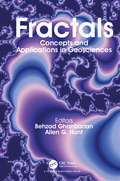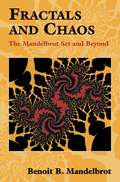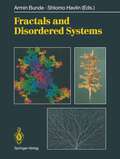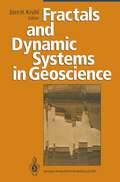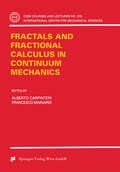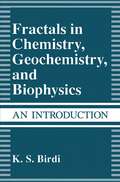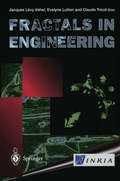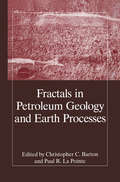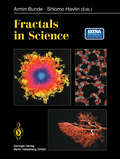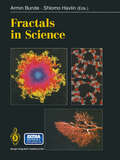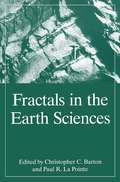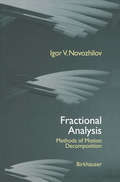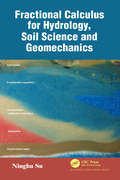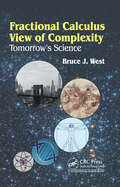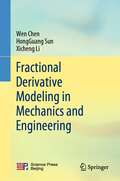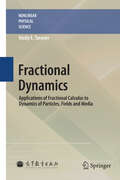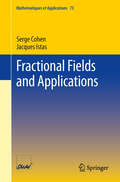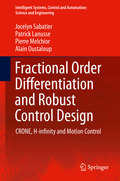- Table View
- List View
Fractals: Concepts and Applications in Geosciences
by Behzad Ghanbarian Allen G. HuntThis book provides theoretical concepts and applications of fractals and multifractals to a broad range of audiences from various scientific communities, such as petroleum, chemical, civil and environmental engineering, atmospheric research, and hydrology. In the first chapter, we introduce fractals and multifractals from physics and math viewpoints. We then discuss theory and practical applications in detail. In what follows, in chapter 2, fragmentation process is modeled using fractals. Fragmentation is the breaking of aggregates into smaller pieces or fragments, a typical phenomenon in nature. In chapter 3, the advantages and disadvantages of two- and three-phase fractal models are discussed in detail. These two kinds of approach have been widely applied in the literature to model different characteristics of natural phenomena. In chapter 4, two- and three-phase fractal techniques are used to develop capillary pressure curve models, which characterize pore-size distribution of porous media. Percolation theory provides a theoretical framework to model flow and transport in disordered networks and systems. Therefore, following chapter 4, in chapter 5 the fractal basis of percolation theory and its applications in surface and subsurface hydrology are discussed. In chapter 6, fracture networks are shown to be modeled using fractal approaches. Chapter 7 provides different applications of fractals and multifractals to petrophysics and relevant area in petroleum engineering. In chapter 8, we introduce the practical advantages of fractals and multifractals in geostatistics at large scales, which have broad applications in stochastic hydrology and hydrogeology. Multifractals have been also widely applied to model atmospheric characteristics, such as precipitation, temperature, and cloud shape. In chapter 9, these kinds of properties are addressed using multifractals. At watershed scales, river networks have been shown to follow fractal behavior. Therefore, the applications of fractals are addressed in chapter 10. Time series analysis has been under investigations for several decades in physics, hydrology, atmospheric research, civil engineering, and water resources. In chapter 11, we therefore, provide fractal, multifractal, multifractal detrended fluctuation analyses, which can be used to study temporal characterization of a phenomenon, such as flow discharge at a specific location of a river. Chapter 12 addresses signals and again time series using a novel fractal Fourier analysis. In chapter 13, we discuss constructal theory, which has a perspective opposite to fractal theories, and is based on optimizationof diffusive exchange. In the case of river drainages, for example, the constructal approach begins at the divide and generates headwater streams first, rather than starting from the fundamental drainage pattern.
Fractals and Chaos: The Mandelbrot Set and Beyond
by Benoit MandelbrotJust 23 years ago Benoit Mandelbrot published his famous picture of the Mandelbrot set, but that picture has changed our view of the mathematical and physical universe. In this text, Mandelbrot offers 25 papers from the past 25 years, many related to the famous inkblot figure. Of historical interest are some early images of this fractal object produced with a crude dot-matrix printer. The text includes some items not previously published.
Fractals and Disordered Systems
by Armin Bunde Shlomo HavlinFractals and disordered systems have recently become the focus of intense interest in research. This book discusses in great detail the effects of disorder on mesoscopic scales (fractures, aggregates, colloids, surfaces and interfaces, glasses, and polymers) and presents tools to describe them in mathematical language. A substantial part is devoted to the development of scaling theories based on fractal concepts. In 10 chapters written by leading experts in the field, including E. Stanley and B. Mandelbrot, the reader is introduced to basic concepts and techniques in disordered systems and is lead to the forefront of current research. In each chapter the connection between theory and experiment is emphasized, and a special chapter entitled "Fractals and Experiments" presents experimental studies of fractal systems in the laboratory. The book is written pedagogically. It can be used as a textbook for graduate students, by university teachers to prepare courses and seminars, and by active scientists who want to become familiar with a fascinating new field.
Fractals and Dynamic Systems in Geoscience
by L. O. RenftelFractal geometry allows the description of natural patterns and the establishment and testing of models of pattern formation. In particular, it is a tool for geoscientists. The aim of this volume is to give an overview of the applications of fractal geometry and the theory of dynamic systems in the geosciences. The state of the art is presented and the reader obtains an impression of the variety of fields for which fractal geometry is a useful tool and of the different methods of fractal geometry which can be applied. In addition to specific information about new applications of fractal geometry in structural geology, physics of the solid earth, and mineralogy, proposals and ideas about how fractal geometry can be applied in the reader's field of studies will be put forward.
Fractals and Fractional Calculus in Continuum Mechanics (CISM International Centre for Mechanical Sciences #378)
by Alberto Carpinteri Francesco MainardiThe book is characterized by the illustration of cases of fractal, self-similar and multi-scale structures taken from the mechanics of solid and porous materials, which have a technical interest. In addition, an accessible and self-consistent treatment of the mathematical technique of fractional calculus is provided, avoiding useless complications.
Fractals in Chemistry, Geochemistry, and Biophysics: An Introduction
by K.S. BirdiIn this introductory text, Dr. Birdi demonstrates experimental methods and analyses of fractal dimensions in natural processes. In addition to a general overview, he discusses in detail problems in the fields of chemistry, geochemistry, and biophysics. Both students and professionals with a minimum of mathematics or physical science training will learn to find and model shapes and patterns from their own everyday observations.
Fractals in Engineering: From Theory to Industrial Applications
by Jacques Levy Vehel Evelyne Lutton Claude TricotFractal analysis research is expanding into a variety of engineering domains. The strong potential of this work is now beginning to be seen in important applications in real industrial situations. Recent research progress has already led to new developments in domains such as signal processing and chemical engineering, and the major advances in fractal theory that underlie such developments are detailed here. New domains of applications are also presented, among them environmental science and rough surface analysis. Sections include multifractal analysis, iterated function systems, random processes, network traffic analysis, fractals and waves, image compression, and applications in physics. Fractals in Engineering emphasizes the connection between fractal analysis research and applications to industry. It is an important volume that illustrates the scientific and industrial value of this exciting field.
Fractals in Petroleum Geology and Earth Processes
by C. C. Barton P. R. La PointeIn this unique volume, renowned experts discuss the applications of fractals in petroleum research-offering an excellent introduction to the subject. Contributions cover a broad spectrum of applications from petroleum exploration to production. Papers also illustrate how fractal geometry can quantify the spatial heterogeneity of different aspects of geology and how this information can be used to improve exploration and production results.
Fractals in Science
by Armin Bunde Shlomo HavlinA deeply detailed discussion of fractals in biology, heterogeneous chemistry, polymers, and the earth sciences. Beginning with a general introduction to fractal geometry it continues with eight chapters on self-organized criticality, rough surfaces and interfaces, random walks, chemical reactions, and fractals in chemisty, biology, and medicine. A special chapter entitled "Computer Exploration of Fractals, Chaos, and Cooperativity" presents computer demonstrations of fractal models: 14 programs are included on a 3 1/2" MS-DOS diskette which run on any PC with at least 1 MB RAM and a EGA or VGA graphics card, 16 colors.
Fractals in Science
by Armin Bunde Shlomo HavlinThe fractal concept has become an important tool for understanding irregular complex systems in various scientific disciplines. This book discusses in great detail fractals in biology, heterogeneous chemistry, polymers, and the earth sciences. Beginning with a general introduction to fractal geometry it continues with eight chapters on self-organized criticality, rough surfaces and interfaces, random walks, chemical reactions, and fractals in chemistry, biology, and medicine. A special chapter entitled "Computer Exploration of Fractals, Chaos, and Cooperativity" presents computer demonstrations of fractal models.
Fractals in Science: An Introductory Course
by Eugene Stanley Edwin TaylorNature is full of spidery patterns: lightning bolts, coastlines, nerve cells, termite tunnels, bacteria cultures, root systems, forest fires, soil cracking, river deltas, galactic distributions, mountain ranges, tidal patterns, cloud shapes, sequencing of nucleotides in DNA, cauliflower, broccoli, lungs, kidneys, the scraggly nerve cells that carry signals to and from your brain, the branching arteries and veins that make up your circulatory system. These and other similar patterns in nature are called natural fractals or random fractals. This chapter contains activities that describe random fractals. There are two kinds of fractals: mathematical fractals and natural (or random) fractals. A mathematical fractal can be described by a mathematical formula. Given this formula, the resulting structure is always identically the same (though it may be colored in different ways). In contrast, natural fractals never repeat themselves; each one is unique, different from all others. This is because these processes are frequently equivalent to coin-flipping, plus a few simple rules. Nature is full of random fractals. In this book you will explore a few of the many random fractals in Nature. Branching, scraggly nerve cells are important to life (one of the patterns on the preceding pages). We cannot live without them. How do we describe a nerve cell? How do we classify different nerve cells? Each individual nerve cell is special, unique, different from every other nerve cell. And yet our eye sees that nerve cells are similar to one another.
Fractals in the Earth Sciences
by C. C. Barton P. R. La PointeFractals have changed the way we understand and study nature. This change has been brought about mainly by the work of B. B. Mandelbrot and his book The Fractal Geometry of Nature. Now here is a book that collects articles treating fractals in the earth sciences. The themes chosen span, as is appropriate for a discourse on fractals, many orders of magnitude; including earthquakes, ocean floor topography, fractures, faults, mineral crystallinity, gold and silver deposition. There are also chapters on dynamical processes that are fractal, such as rivers, earthquakes, and a paper on self-organized criticality. Many of the chapters discuss how to estimate fractal dimensions, Hurst exponents, and other scaling exponents. This book, in a way, represents a snapshot of a field in which fractals has brought inspiration and a fresh look at familiar subjects. New ideas and attempts to quantify the world we see around us are found throughout. Many of these ideas will grow and inspire further work, others will be superseded by new observations and insights, most probably with future contributions by the authors of these chapters.
Fractional Analysis: Methods of Motion Decomposition
by I.V. NovozhilovThis book considers methods of approximate analysis of mechanical, elec tromechanical, and other systems described by ordinary differential equa tions. Modern mathematical modeling of sophisticated mechanical systems consists of several stages: first, construction of a mechanical model, and then writing appropriate equations and their analytical or numerical ex amination. Usually, this procedure is repeated several times. Even if an initial model correctly reflects the main properties of a phenomenon, it de scribes, as a rule, many unnecessary details that make equations of motion too complicated. As experience and experimental data are accumulated, the researcher considers simpler models and simplifies the equations. Thus some terms are discarded, the order of the equations is lowered, and so on. This process requires time, experimentation, and the researcher's intu ition. A good example of such a semi-experimental way of simplifying is a gyroscopic precession equation. Formal mathematical proofs of its admis sibility appeared some several decades after its successful introduction in engineering calculations. Applied mathematics now has at its disposal many methods of approxi mate analysis of differential equations. Application of these methods could shorten and formalize the procedure of simplifying the equations and, thus, of constructing approximate motion models. Wide application of the methods into practice is hindered by the fol lowing. 1. Descriptions of various approximate methods are scattered over the mathematical literature. The researcher, as a rule, does not know what method is most suitable for a specific case. 2.
Fractional Calculus for Hydrology, Soil Science and Geomechanics: An Introduction to Applications
by Ninghu SuThis book is an unique integrated treatise, on the concepts of fractional calculus as models with applications in hydrology, soil science and geomechanics. The models are primarily fractional partial differential equations (fPDEs), and in limited cases, fractional differential equations (fDEs). It develops and applies relevant fPDEs and fDEs mainly to water flow and solute transport in porous media and overland, and in some cases, to concurrent flow and energy transfer. It is an integrated resource with theory and applications for those interested in hydrology, hydraulics and fluid mechanics. The self-contained book summaries the fundamentals for porous media and essential mathematics with extensive references supporting the development of the model and applications.
Fractional Calculus for Hydrology, Soil Science and Geomechanics: An Introduction to Applications
by Ninghu SuThis book is an unique integrated treatise, on the concepts of fractional calculus as models with applications in hydrology, soil science and geomechanics. The models are primarily fractional partial differential equations (fPDEs), and in limited cases, fractional differential equations (fDEs). It develops and applies relevant fPDEs and fDEs mainly to water flow and solute transport in porous media and overland, and in some cases, to concurrent flow and energy transfer. It is an integrated resource with theory and applications for those interested in hydrology, hydraulics and fluid mechanics. The self-contained book summaries the fundamentals for porous media and essential mathematics with extensive references supporting the development of the model and applications.
Fractional Calculus View of Complexity: Tomorrow's Science
by Bruce J. WestThis book is not a text devoted to a pedagogical presentation of a specialized topic nor is it a monograph focused on the author's area of research. It accomplishes both these things while providing a rationale for why the reader ought to be interested in learning about fractional calculus. This book is for researchers who has heard about many
Fractional Derivative Modeling in Mechanics and Engineering
by Wen Chen HongGuang Sun Xicheng LiThis textbook highlights the theory of fractional calculus and its wide applications in mechanics and engineering. It describes in details the research findings in using fractional calculus methods for modeling and numerical simulation of complex mechanical behavior. It covers the mathematical basis of fractional calculus, the relationship between fractal and fractional calculus, unconventional statistics and anomalous diffusion, typical applications of fractional calculus, and the numerical solution of the fractional differential equation. It also includes latest findings, such as variable order derivative, distributed order derivative and its applications. Different from other textbooks in this subject, the book avoids lengthy mathematical demonstrations, and presents the theories in close connection to the applications in an easily readable manner. This textbook is intended for students, researchers and professionals in applied physics, engineering mechanics, and applied mathematics. It is also of high reference value for those in environmental mechanics, geotechnical mechanics, biomechanics, and rheology.
Fractional Derivatives for Physicists and Engineers: Volume I Background and Theory Volume II Applications (Nonlinear Physical Science)
by Vladimir V. UchaikinThe first derivative of a particle coordinate means its velocity, the second means its acceleration, but what does a fractional order derivative mean? Where does it come from, how does it work, where does it lead to? The two-volume book written on high didactic level answers these questions. Fractional Derivatives for Physicists and Engineers— The first volume contains a clear introduction into such a modern branch of analysis as the fractional calculus. The second develops a wide panorama of applications of the fractional calculus to various physical problems. This book recovers new perspectives in front of the reader dealing with turbulence and semiconductors, plasma and thermodynamics, mechanics and quantum optics, nanophysics and astrophysics. The book is addressed to students, engineers and physicists, specialists in theory of probability and statistics, in mathematical modeling and numerical simulations, to everybody who doesn't wish to stay apart from the new mathematical methods becoming more and more popular.Prof. Vladimir V. UCHAIKIN is a known Russian scientist and pedagogue, a Honored Worker of Russian High School, a member of the Russian Academy of Natural Sciences. He is the author of about three hundreds articles and more than a dozen books (mostly in Russian) in Cosmic ray physics, Mathematical physics, Levy stable statistics, Monte Carlo methods with applications to anomalous processes in complex systems of various levels: from quantum dots to the Milky Way galaxy.
Fractional Derivatives with Mittag-Leffler Kernel: Trends and Applications in Science and Engineering (Studies in Systems, Decision and Control #194)
by José Francisco Gómez Lizeth Torres Ricardo Fabricio EscobarThis book offers a timely overview of fractional calculus applications, with a special emphasis on fractional derivatives with Mittag-Leffler kernel. The different contributions, written by applied mathematicians, physicists and engineers, offers a snapshot of recent research in the field, highlighting the current methodological frameworks together with applications in different fields of science and engineering, such as chemistry, mechanics, epidemiology and more. It is intended as a timely guide and source of inspiration for graduate students and researchers in the above-mentioned areas.
Fractional Dynamic Calculus and Fractional Dynamic Equations on Time Scales
by Svetlin G. GeorgievPedagogically organized, this monograph introduces fractional calculus and fractional dynamic equations on time scales in relation to mathematical physics applications and problems. Beginning with the definitions of forward and backward jump operators, the book builds from Stefan Hilger’s basic theories on time scales and examines recent developments within the field of fractional calculus and fractional equations. Useful tools are provided for solving differential and integral equations as well as various problems involving special functions of mathematical physics and their extensions and generalizations in one and more variables. Much discussion is devoted to Riemann-Liouville fractional dynamic equations and Caputo fractional dynamic equations. Intended for use in the field and designed for students without an extensive mathematical background, this book is suitable for graduate courses and researchers looking for an introduction to fractional dynamic calculus and equations on time scales.
Fractional Dynamics: Applications of Fractional Calculus to Dynamics of Particles, Fields and Media (Nonlinear Physical Science)
by Vasily E. Tarasov"Fractional Dynamics: Applications of Fractional Calculus to Dynamics of Particles, Fields and Media" presents applications of fractional calculus, integral and differential equations of non-integer orders in describing systems with long-time memory, non-local spatial and fractal properties. Mathematical models of fractal media and distributions, generalized dynamical systems and discrete maps, non-local statistical mechanics and kinetics, dynamics of open quantum systems, the hydrodynamics and electrodynamics of complex media with non-local properties and memory are considered. This book is intended to meet the needs of scientists and graduate students in physics, mechanics and applied mathematics who are interested in electrodynamics, statistical and condensed matter physics, quantum dynamics, complex media theories and kinetics, discrete maps and lattice models, and nonlinear dynamics and chaos. Dr. Vasily E. Tarasov is a Senior Research Associate at Nuclear Physics Institute of Moscow State University and an Associate Professor at Applied Mathematics and Physics Department of Moscow Aviation Institute.
Fractional Equations and Models: Theory and Applications (Developments in Mathematics #61)
by Trifce Sandev Živorad TomovskiFractional equations and models play an essential part in the description of anomalous dynamics in complex systems. Recent developments in the modeling of various physical, chemical and biological systems have clearly shown that fractional calculus is not just an exotic mathematical theory, as it might have once seemed. The present book seeks to demonstrate this using various examples of equations and models with fractional and generalized operators. Intended for students and researchers in mathematics, physics, chemistry, biology and engineering, it systematically offers a wealth of useful tools for fractional calculus.
Fractional Fields and Applications (Mathématiques et Applications #73)
by Serge Cohen Jacques IstasThis book focuses mainly on fractional Brownian fields and their extensions. It has been used to teach graduate students at Grenoble and Toulouse's Universities. It is as self-contained as possible and contains numerous exercises, with solutions in an appendix. After a foreword by Stéphane Jaffard, a long first chapter is devoted to classical results from stochastic fields and fractal analysis. A central notion throughout this book is self-similarity, which is dealt with in a second chapter with a particular emphasis on the celebrated Gaussian self-similar fields, called fractional Brownian fields after Mandelbrot and Van Ness's seminal paper. Fundamental properties of fractional Brownian fields are then stated and proved. The second central notion of this book is the so-called local asymptotic self-similarity (in short lass), which is a local version of self-similarity, defined in the third chapter. A lengthy study is devoted to lass fields with finite variance. Among these lass fields, we find both Gaussian fields and non-Gaussian fields, called Lévy fields. The Lévy fields can be viewed as bridges between fractional Brownian fields and stable self-similar fields. A further key issue concerns the identification of fractional parameters. This is the raison d'être of the statistics chapter, where generalized quadratic variations methods are mainly used for estimating fractional parameters. Last but not least, the simulation is addressed in the last chapter. Unlike the previous issues, the simulation of fractional fields is still an area of ongoing research. The algorithms presented in this chapter are efficient but do not claim to close the debate.
Fractional-in-Time Semilinear Parabolic Equations and Applications (Mathématiques et Applications #84)
by Ciprian G. Gal Mahamadi WarmaThis book provides a unified analysis and scheme for the existence and uniqueness of strong and mild solutions to certain fractional kinetic equations. This class of equations is characterized by the presence of a nonlinear time-dependent source, generally of arbitrary growth in the unknown function, a time derivative in the sense of Caputo and the presence of a large class of diffusion operators. The global regularity problem is then treated separately and the analysis is extended to some systems of fractional kinetic equations, including prey-predator models of Volterra–Lotka type and chemical reactions models, all of them possibly containing some fractional kinetics. Besides classical examples involving the Laplace operator, subject to standard (namely, Dirichlet, Neumann, Robin, dynamic/Wentzell and Steklov) boundary conditions, the framework also includes non-standard diffusion operators of "fractional" type, subject to appropriate boundary conditions.This book is aimed at graduate students and researchers in mathematics, physics, mathematical engineering and mathematical biology, whose research involves partial differential equations.
Fractional Order Differentiation and Robust Control Design: CRONE, H-infinity and Motion Control (Intelligent Systems, Control and Automation: Science and Engineering #10)
by Jocelyn Sabatier Patrick Lanusse Pierre Melchior Alain OustaloupThis book provides an overview of the research done and results obtained during the last ten years in the fields of fractional systems control, fractional PI and PID control, robust and CRONE control, and fractional path planning and path tracking. Coverage features theoretical results, applications and exercises. The book will be useful for post-graduate students who are looking to learn more on fractional systems and control. In addition, it will also appeal to researchers from other fields interested in increasing their knowledge in this area.
